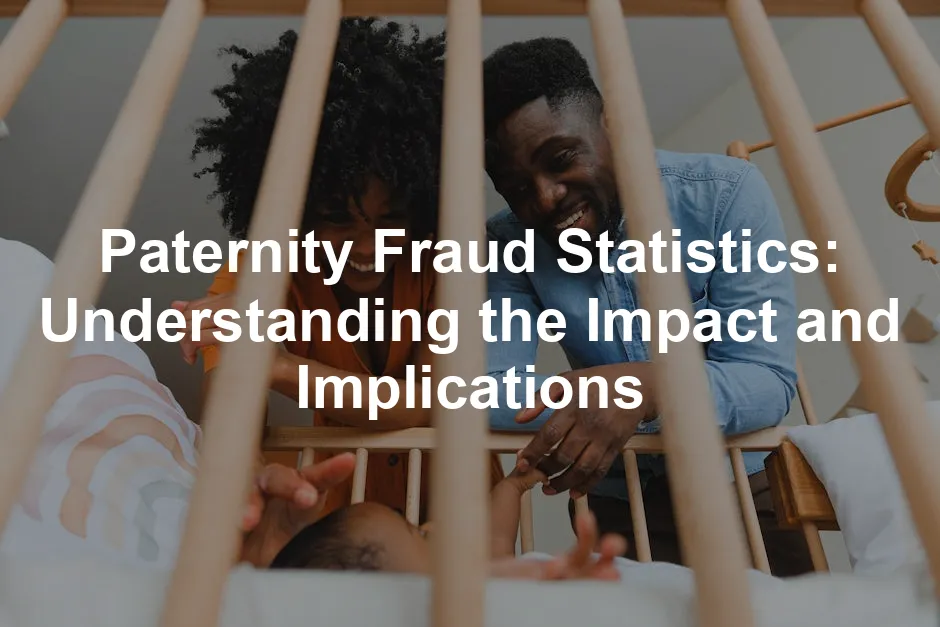Introduction
Paternity fraud is no laughing matter, but it certainly has its share of tragic humor. Imagine believing you’re the proud father, only to find out your little one has no biological connection to you. Awkward. This widespread deception misrepresents parenthood, leaving emotional and financial wreckage in its wake. Paternity fraud can shake the very foundations of family dynamics, altering relationships and trust.
The emotional implications are staggering. Victims often face a rollercoaster of feelings: betrayal, confusion, and heartbreak. Financially, the consequences can be equally severe. Men may find themselves on the hook for child support payments for children they did not father. This raises questions about responsibility and the legal framework surrounding child support, which often favors the mother, even in cases of misattributed paternity.
Why should we care about paternity fraud statistics? Because these numbers reveal the prevalence of this issue, helping us understand its impact on families and society at large. This article aims to shine a light on the statistics surrounding paternity fraud, its frequency, and the broader implications for those affected. From emotional distress to financial burdens, it’s time to unpack the reality behind these statistics and their significance.

Understanding the statistics surrounding paternity fraud is essential for grasping its impact on society. an introduction to statistical learning with python book length
What is Paternity Fraud?
Paternity fraud occurs when a mother intentionally misidentifies a man as the biological father of her child. This misrepresentation can lead to unjust child support obligations and emotional turmoil. Legally, paternity fraud has serious implications, as it can affect custody arrangements, inheritance rights, and more. Imagine believing you have a loving bond with your child, only to discover that bond was built on a lie.
Victims typically face emotional distress upon learning the truth. They grapple with feelings of betrayal and anger, often questioning their role as a father. The family dynamics shift dramatically, creating rifts that may never fully heal. To illustrate, consider the case of a man who paid years of child support, only to find out through a DNA test that he was not the biological father. The emotional toll of such a discovery can be devastating, leading to resentment and fractured relationships.
Understanding paternity fraud is crucial in family law and child support discussions. It highlights the need for accurate paternity testing and the potential for legal reforms. Acknowledging the emotional and financial consequences of paternity fraud can prompt better support systems for victims.
In a world where trust is paramount, paternity fraud shatters that trust, leaving a wake of confusion and heartache. It is essential to recognize the complexities surrounding this issue, as they shape the experiences of those directly affected. By delving deeper into the statistics and personal stories, we can better understand the scope of paternity fraud and work towards solutions that protect the rights and well-being of families.

How Does Paternity Fraud Occur?
Paternity fraud is a tricky phenomenon that can occur through several mechanisms. Understanding these mechanisms is vital to recognizing how this deceitful practice takes root in families. Let’s break down the common ways paternity fraud occurs.
Mechanisms of Paternity Fraud
Erroneous Birth Certificate Information
One of the most common ways paternity fraud unfolds is through incorrect information on birth certificates. When a child is born, the mother typically fills out the birth certificate, listing the child’s father. If she mistakenly or intentionally lists the wrong man, that innocent individual is legally recognized as the child’s father. This document becomes a binding legal record, which can lead to a host of issues down the line.
Imagine a scenario where a mother, after a whirlwind romance, names her new boyfriend on the birth certificate, believing he is the father. Later, she discovers that her ex-partner is the biological father. Suddenly, the man listed on the birth certificate must navigate the murky waters of parental rights and responsibilities, even though he may have no biological connection to the child.
This situation not only puts emotional strain on everyone involved but also complicates legal matters. The wrongly identified father may be held accountable for child support, while the biological father remains hidden in the shadows. This can lead to feelings of betrayal, confusion, and anger when the truth finally comes to light.
If you’re looking for clarity in your family matters, consider a DNA Paternity Test Kit. This kit can help clear up any doubts and provide peace of mind, ensuring that you are accurately informed about your familial connections.

Deliberate Manipulation
In some unfortunate cases, paternity fraud is a calculated act. A mother may knowingly misidentify a father for financial gain. This manipulation often stems from a desire to secure child support payments from an unsuspecting man.
Take a case where a woman has an affair and ends up pregnant. Rather than confessing to her partner, she decides to name him as the father, even though she knows the biological father is someone else. This deceit allows her to receive financial support under false pretenses, leaving the wronged man potentially facing years of child support payments.
These situations can escalate to legal battles that drain emotional and financial resources. The fallout from deliberate manipulation can be devastating, leading to broken families and long-lasting resentment.
Miscommunication or Misunderstanding
Not all instances of paternity fraud are rooted in malice. Sometimes, paternity fraud arises from genuine misunderstandings. For instance, if a mother has had relationships with multiple partners around the time of conception, she may genuinely believe a certain man is the father, leading to misattributed paternity.
In these situations, the mother might not be fully aware of the implications of her choices. Perhaps she misremembers the timeline of her relationships, or maybe she simply makes an assumption based on the circumstances surrounding her pregnancy. This unintentional misidentification can have significant consequences when the truth eventually surfaces.
The emotional toll on all parties involved can be substantial. The man who believed he was the father may feel betrayed, while the mother may face societal judgment for her perceived infidelity. Children caught in the middle may struggle with identity issues, unsure of their true parentage.
To better support families navigating these challenges, consider exploring a Parenting Guidebook. This resource can provide valuable insights into effective parenting strategies and communication techniques that can help prevent misunderstandings.

Factors Contributing to Paternity Fraud
Several factors contribute to the prevalence of paternity fraud, including cultural, social, and economic influences. Societal norms surrounding family structures can shape how individuals perceive paternity and fatherhood. In some cultures, financial assistance and social status may encourage mothers to misidentify fathers to gain support.
Technological advancements, particularly in DNA testing, have brought paternity fraud to the forefront. While these tests offer clarity, they also expose individuals to the harsh realities of misattributed paternity. As more men opt for testing, the statistics surrounding paternity fraud are beginning to surface, highlighting the need for awareness and change in societal attitudes.
In summary, paternity fraud can occur through erroneous birth certificate information, deliberate manipulation, or genuine misunderstandings. Understanding these mechanisms is crucial for addressing the emotional and legal implications that arise from this complex issue.

The Importance of Paternity Fraud Statistics
Paternity fraud is a topic often shrouded in stigma and misunderstanding. Yet, the statistics surrounding it reveal a complex web of emotional turmoil and legal ramifications. Understanding these statistics is crucial for various stakeholders, from lawmakers to family law practitioners. They provide insight into the prevalence of paternity fraud and its broader implications for society.
Overview of Paternity Fraud Statistics
Studies indicate that paternity fraud rates can vary widely, with estimates ranging from as low as 1% to as high as 30%. In the UK, a 2018 study by the University of Warwick found that about 3% of men tested were not the biological fathers of the children they believed to be theirs. However, a more recent analysis from DNA Clinics reported a staggering 48% non-paternity rate among 5,000 tested men. The United States also reflects these concerning trends: a 2022 study published in “Human Reproduction” found that 11% of men seeking paternity testing discovered they were not the biological fathers.
The implications of these statistics extend far beyond mere numbers. They highlight the significant strain on family law and child support systems. When men are misidentified as fathers, they may be liable for child support payments, often without any biological connection to the child. This creates not only financial burdens but also emotional distress. A man discovering he has been raising a child that isn’t biologically his can feel a profound sense of betrayal and confusion. Furthermore, these statistics prompt discussions about the need for legal reform and better paternity testing protocols.

Insights from Recent Studies
Recent research offers deeper insights into the phenomenon of paternity fraud. A 2023 study published in “Family Relations” found that 12% of men mandated by courts for paternity testing were not the biological fathers. These findings underline the role of social factors, such as relationship dynamics and cultural expectations, in influencing non-paternity rates.
The emotional impact of discovering paternity fraud can be devastating. Victims often experience a whirlwind of feelings, including anger, confusion, and sorrow. The psychological ramifications can ripple through entire families, leading to strained relationships and a breakdown of trust. Personal accounts reveal that many men choose to maintain legal paternity to stay connected to the child, even after learning they are not biologically related. This complex emotional landscape highlights the need for a more compassionate approach to family law, one that considers the human element behind the statistics.
Paternity fraud remains a nuanced issue requiring careful consideration. The statistics serve not just as numbers but as a call to action for better awareness and legal reform. Understanding the prevalence of paternity fraud can guide policymakers in creating laws that protect both children and fathers, ensuring that the best interests of families are prioritized.

Uncovering the Many Faces of Paternity Fraud
Emotional and Financial Consequences
Paternity fraud isn’t just a legal issue; it’s a heart-wrenching emotional rollercoaster. Imagine waking up one day to discover that your whole life has been based on a lie. It’s like finding out your favorite childhood story was entirely fabricated. The emotional toll on victims is profound. Many report feelings of betrayal, confusion, and anger.
Take John, for instance. He spent over a decade believing he was the father of a happy little boy. He paid child support, went to school plays, and celebrated birthdays. Then came the day he decided to take a DNA test. The results? His son was not biologically his. “I felt like I was hit by a truck,” John recalled. “Everything I did for that child was based on a falsehood.”
Financially, the consequences can be equally staggering. Victims often find themselves tied to child support for children they never fathered. This situation not only strains their finances but also their future relationships. Imagine having to explain to your new partner why you’re still paying for a child who isn’t yours. It’s not just about money; it’s about trust and emotional security.
Additionally, the ripple effects extend to family dynamics. When the truth comes to light, relationships can fracture. Siblings may feel the strain, and mothers may face backlash from their partners. The child may also suffer from identity issues, leading to long-term psychological impacts. To support healthy family interactions, consider a Family Law Book that can provide insights into navigating these complex situations.

Legal Challenges and Navigating the System
Navigating the legal landscape surrounding paternity fraud is like trying to find your way through a labyrinth. The laws can vary wildly by jurisdiction, creating confusion and frustration for those affected. In some regions, legal paternity is determined by the name on the birth certificate, regardless of biological ties. This means that even if a DNA test proves otherwise, the man listed as the father may still be held responsible for child support.
Consider Sarah, who found herself embroiled in a legal nightmare. After discovering through a paternity test that her husband was not the biological father of their child, she sought to have the child’s birth certificate amended. However, local laws made it nearly impossible to change the legal father without significant legal hurdles. “I felt trapped,” she said. “I just wanted to do the right thing for my son.”
Moreover, many fathers face difficulties in gaining custody or visitation rights post-discovery. Courts often prioritize the established father-child relationship over biological connections. This can leave innocent men paying not only for child support but also for emotional turmoil as they fight for their rights.
The complexities of family law can make it hard for victims to find justice. Many feel that the system favors mothers, leaving fathers feeling powerless. As a result, the legal implications of paternity fraud extend far beyond simple financial burdens; they can lead to emotional distress and strained relationships for all parties involved.

Societal Stigma and Support Systems
Society often carries a heavy stigma when it comes to paternity fraud. Many victims feel shame for being duped, while others may face judgment from friends and family. This stigma can discourage open discussions about paternity fraud, leaving victims feeling isolated.
“People think you should just know,” says Mark, a victim of paternity fraud. “But how could I? I trusted her.” This societal pressure can lead to mental health struggles, including anxiety and depression. Victims often feel they must keep their stories hidden, fearing judgment from their peers.
Support systems are crucial for those affected. Peer groups, therapy, and legal advocacy can provide essential resources. Organizations that focus on family law reform can also be invaluable. They advocate for policies that protect the rights of fathers and children alike.
However, the availability of support varies widely. In some areas, resources are limited, leaving victims to navigate their emotions and legal battles alone. Creating awareness and fostering dialogues about paternity fraud can help break down these societal barriers. If you’re looking for additional support, consider joining a Parenting Support Group Guide to help you connect with others who understand your struggles.
In conclusion, the multifaceted nature of paternity fraud—encompassing emotional, legal, and societal dimensions—makes it a complex issue. Victims face a daunting journey, but with increased awareness and better support systems, there is hope for healing and resolution.

Conclusion
Paternity fraud is a complex issue that wields significant emotional, legal, and social implications. At its core, it involves the intentional misrepresentation of a child’s biological father, often resulting in devastating consequences for everyone involved. Victims, primarily men, face the heartbreaking realization that they have been raising a child who is not biologically theirs. The emotional turmoil can lead to feelings of betrayal, confusion, and anger, often fracturing relationships and family dynamics.
The financial ramifications are equally troubling. Many men find themselves burdened with child support payments for children they did not father. This creates a troubling cycle where innocent individuals are held responsible for financial obligations based on a lie. Such situations raise serious questions about the fairness and effectiveness of child support laws, which often seem to favor mothers regardless of the underlying truths.
Despite the seriousness of paternity fraud, awareness remains low. Many individuals, including potential victims, are unaware of the prevalence and implications of this deception. Thus, it is crucial to emphasize the need for education around paternity fraud. Increased awareness can empower individuals to seek proof of paternity and question assumptions that could lead to significant emotional and financial costs.
Moreover, policy reform is essential. Legal systems must adapt to the realities of paternity fraud, ensuring that men are not unjustly held accountable for children they did not father. This could include revising laws regarding paternity testing, child support, and legal fatherhood, creating a more equitable environment for all parties involved.
Finally, comprehensive research and data collection are vital to understand the full scope of paternity fraud. Reliable statistics can inform both policymakers and the public, shedding light on the prevalence and consequences of this issue. By gathering accurate data, we can develop targeted interventions and support systems that address the needs of victims, ultimately fostering healthier family structures. If you’re interested in self-improvement and understanding these dynamics better, consider reading an Self-help Book on Trust Issues to guide you through rebuilding trust in your relationships.
In conclusion, tackling paternity fraud requires a blend of awareness, education, policy reform, and research. By recognizing the complexities and far-reaching impacts of this issue, society can begin to address the root causes and help those affected find pathways to healing and resolution.

FAQs
What is the most common reason for paternity fraud?
Paternity fraud often stems from several motivations. Financial gain is a primary driver. Some mothers may deliberately misidentify a father to secure child support payments from an unsuspecting man. This manipulation can lead to significant financial repercussions for the victim. Another reason is miscommunication or misunderstanding. Sometimes, a mother genuinely believes a certain man is the biological father due to a lack of clarity regarding her relationships. This misidentification can occur when multiple partners are involved, leading to confusion about paternity. Additionally, societal pressures and cultural norms can play a role. In some communities, financial support from a non-biological father is expected, pushing mothers to misidentify fathers to meet those expectations. Ultimately, the reasons for paternity fraud can be complex and varied, requiring a nuanced understanding of individual circumstances.
How can someone protect themselves from paternity fraud?
Protecting oneself from paternity fraud involves proactive steps. Firstly, consider paternity testing before accepting legal responsibilities. Using DNA tests can provide clarity about biological connections, especially if doubts arise during pregnancy or after a child’s birth. Consulting with legal professionals is also crucial. Men should seek legal advice before signing any acknowledgment of paternity or birth certificates, particularly in uncertain situations. Understanding local laws regarding paternity and child support can help individuals navigate these complexities. Open communication with partners about relationships and potential paternity issues can prevent misunderstandings. Being transparent about past relationships and expectations can foster trust and reduce the risk of future disputes.
What are the legal implications of paternity fraud?
The legal implications of paternity fraud can be severe. If a man is misidentified as a father, he may be held liable for child support payments, even if DNA testing later reveals he is not the biological parent. This creates an unfair burden on the wronged individual. Additionally, the legal system often prioritizes the established father-child relationship over biological ties. This means that even after proving he is not the biological father, a man may struggle to gain custody or visitation rights. In many jurisdictions, laws surrounding paternity are outdated, failing to account for the realities of modern family dynamics. As a result, individuals caught up in paternity fraud cases often face lengthy and complicated legal battles, compounding the emotional and financial toll.
How prevalent is paternity fraud in different countries?
Paternity fraud rates vary significantly across countries. In the UK, studies suggest rates range from 1% to as high as 30%. A 2018 study estimated about 3% of tested men were not biological fathers, while a DNA Clinics analysis revealed a staggering 48% non-paternity rate among 5,000 tested men. In the United States, a 2022 study found that 11% of men seeking paternity testing discovered they were not the biological fathers. These statistics highlight a concerning trend that transcends borders, emphasizing the need for awareness and reform in family law. Countries in Africa also report high instances of paternity fraud, with anecdotal evidence suggesting significant prevalence. However, due to a lack of comprehensive studies, it’s challenging to ascertain the true extent of the issue.
What should someone do if they suspect paternity fraud?
If someone suspects paternity fraud, the first step is to seek clarity through paternity testing. A DNA test can provide definitive answers about biological connections. Once the results are obtained, individuals should consult with a legal professional. An attorney can offer guidance on navigating the complexities of family law, including potential child support obligations and custody rights. Open communication with all parties involved is vital. Discussing concerns with the mother and other family members can help address misunderstandings and clarify relationships. Finally, seeking emotional support from friends, family, or counseling services can help navigate the emotional fallout from discovering paternity fraud. It’s essential to prioritize mental health during this challenging time.
Please let us know what you think about our content by leaving a comment down below!
Thank you for reading till here 🙂
All images from Pexels




